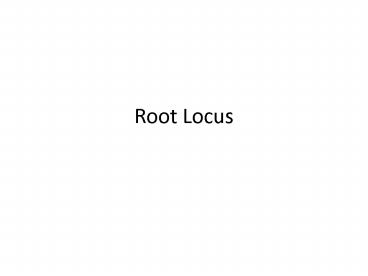Root Locus PowerPoint PPT Presentation
1 / 97
Title: Root Locus
1
Root Locus
2
Closed-loop control system with a variable
parameter K.
3
Unity feedback control system. The gain K is a
variable parameter.
4
Root locus for a second-order system when
KeltK1ltK2. The locus is shown in color.
5
Evaluation of the angle and gain at s1,for gain
KK1.
6
(a) Single-loop system. (b) Root locus as a
function of the parameter a.
7
(a) The zero and poles of a second-order
system,(b) the root locus segments,and (c) the
magnitude of each vector at s1.
8
A fourth-order system with (a) a zero and (b)
root locus.
9
Illustration of the breakaway point (a) for a
simple second-order system and (b) for a
fourth-order system.
10
A graphical evaluation of the breakaway point.
11
Closed-loop system.
12
Evaluation of the (a) asymptotes and (b)
breakaway point.
13
Illustration of the angle of departure(a) Test
point infinitesimal distance from p1(b) actual
departure vector at p1
14
Evaluation of the angle of departure.
15
(No Transcript)
16
The root locus for Example 7.4locating (a) the
poles and (b) the asymptotes.
17
- 1.Write the characteristic equation in pole-zero
form so that the parameter of interest k appears
as 1kF(s)O. - 2.Locate the open-loop poles and zeros of F(s) in
the s-plane. - 3.Locate the segments of the real axis that are
root loci. - 4.Determinethenumberofseparateloci.
- 5.Locate the angles of the asymptotes and the
center of the asymptotes. - 6.Determine the break away point on the real
axis(if any). - 7.By utilizing the Routh-Hurwitz criterion,
determine the point at which the locus crosses
the imaginary axis(if it does so). - 8.Estimate the angle of locus departure from
complex poles and the angle locus arrival at
complex zeros.
18
(No Transcript)
19
(No Transcript)
20
(No Transcript)
21
(No Transcript)
22
(No Transcript)
23
(No Transcript)
24
(No Transcript)
25
Root loci as a function of a and ß(a) loci as a
varies (b) loci as ß varies for one value of a
a1
26
(No Transcript)
27
A region in the s-plane for desired root location.
28
(No Transcript)
29
(No Transcript)
30
(No Transcript)
31
(No Transcript)
32
(No Transcript)
33
(No Transcript)
34
A feedback control system.
35
Closed-loop system with a controller.
36
Root locus for plant with a PID controller with
complex zeros.
37
Laser manipulator control system.
38
Root locus for a laser control system.
39
The response to a ramp input for a laser control
system.
40
Proposed configuration for control of the
lightweight robot arm.
41
Root locus of the system if K20,and K1 is
variedfrom K10 to K18,and Gc(s)K1.
42
Root locus for the robot controller with a zero
inserted at s-0.2 with Gc(s) K1.
43
Using the rlocus function.
44
Disk drive control system with a PD controller.
45
Sketch of the root locus.
46
Root Locus Plots for Typical Transfer Functions
(continued).
47
Root Locus Plots for Typical Transfer Functions
(continued).
48
Root Locus Plots for Typical Transfer Functions
(continued).
49
Root Locus Plots for Typical Transfer Functions
(continued).
50
Root Locus Plots for Typical Transfer Functions
(continued).
51
Root Locus Plots for Typical Transfer Functions
(continued).
52
Root Locus Plots for Typical Transfer Functions
(continued).
53
Root Locus Plots for Typical Transfer Functions
(continued).
54
Root Locus Plots for Typical Transfer Functions
(continued).
55
Root Locus Plots for Typical Transfer Functions
(continued).
56
Root Locus Plots for Typical Transfer Functions
(continued).
57
Root Locus Plots for Typical Transfer Functions
(continued).
58
Root Locus Plots for Typical Transfer Functions
(continued).
59
Root Locus Plots for Typical Transfer Functions
(continued).
60
Root Locus Plots for Typical Transfer Functions
(continued).
61
(No Transcript)
62
(No Transcript)
63
(No Transcript)
64
(No Transcript)
65
(No Transcript)
66
(No Transcript)
67
(No Transcript)
68
(No Transcript)
69
(No Transcript)
70
(No Transcript)
71
(No Transcript)
72
(No Transcript)
73
(No Transcript)
74
(No Transcript)
75
(No Transcript)
76
(No Transcript)
77
(No Transcript)
78
(No Transcript)
79
(No Transcript)
80
(No Transcript)
81
(No Transcript)
82
(No Transcript)
83
(No Transcript)
84
(No Transcript)
85
(No Transcript)
86
(No Transcript)
87
(No Transcript)
88
(No Transcript)
89
(No Transcript)
90
(No Transcript)
91
(No Transcript)
92
(No Transcript)
93
(No Transcript)
94
(No Transcript)
95
(No Transcript)
96
(No Transcript)
97
(No Transcript)

